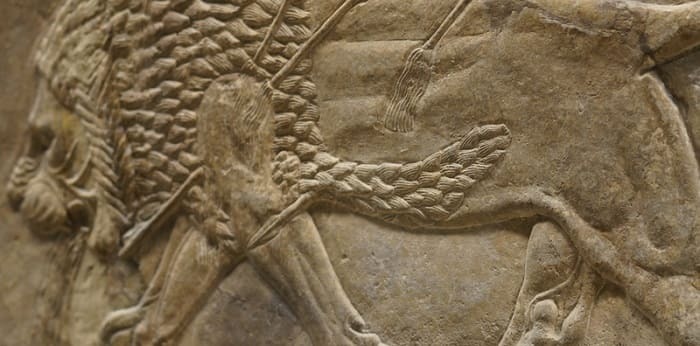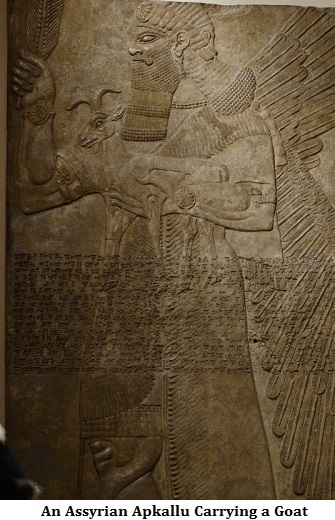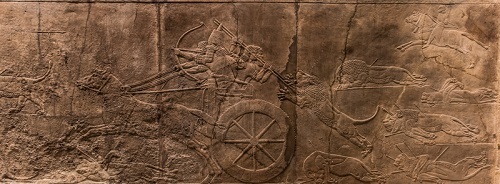

The Assyrian empire, also called, ‘the first military power in history’, had been well known for its fearsome soldiers and creative general.
Before the conquests of Alexander the Great and the Roman Empire, Assyria is considered to become the greatest empire in the ancient world from being a small trading community. Assyrians were well known for their administrative skills and diplomatic supremacy. They initially ruled Ancient Egypt in the South region, through Mesopotamia and the Levant and over to Asia Minor. Assyrians took warfare to new heights as compared to Sumerians, Babylonians, and Akkadians.

The Assyrian Empire started in the second millennium in the northern part of Mesopotamia as a major regional power and existed for almost 300 years i.e. from 1000 to 609 BC.  It was known to be the most powerful military force as their whole economy and wealth were dependent on the conquest of Babylonia, Mesopotamia, western Iran Syria, Urartu (Armenia) etc.
It was known to be the most powerful military force as their whole economy and wealth were dependent on the conquest of Babylonia, Mesopotamia, western Iran Syria, Urartu (Armenia) etc.
Despite being an independent state, it fell into the Babylonian Empire and then into Mittani rule. Other nation-states failed to power due to a lack of technological advances in warfare whereas the Assyrians grew because of these technological advances.
They took over territories by strategically setting up relay systems and building roads to carry messages throughout their empire about food placed and war supplies stored in storage, ensuring necessary logistics and administration ready all the time.
The Assyrians gained more power under Mittani rule as the Hittites led to chaos and war. This created a vacuum in that region causing Assyrians to grow in power. With the Assyrian king Adad Nirari II, who used the latest warfare techniques to acquire enemy cities, the Assyrian borders expanded to a huge Empire. Being the first developer of iron weapons, the Assyrians upskilled themselves in ironworking and made cheaper weapons and protective items. The Assyrians' army was the first to have a separate engineering unit and also the first to build chariots proving protection in battlegrounds. The Assyrian empire expanded by attacking and offending the neighbouring areas.

With more power over the years, the Assyrian Empire kept expanding and became too large which led to its fall. After the fall, the legacy continued for warfare strategies and technologies further adopted by upcoming civilizations.
The Assyrians had used their militaries successfully and very cautiously, thereby taking a lead in numbers for the troops, along with experience and competence. This continued for no less than three centuries.
Assyrians were experts in Logistics as they build storage depots for their army along the roads
On a war campaign, the king was accompanied by his family, advisors, servants, and entertainment
Their army was the first to use cavalry
The inflated sheep skins were used to keep rafts afloat to transport heavy chariots across rivers
Assyria originated from a region around Ashur (currently in northern Iraq) having a stretch of area from Egypt to Anatolia. Since its origin in the second millennium, it grew in power with time passing and was the greatest in the 9th century BC with its conquests of the Mediterranean Sea. The Assyrians were famous for their cruelty and the fights also had built monuments as per the archaeological findings from Ashur and Calah. The Assyrians Kingdom was defeated in 612-609 BC, by merging Media and Babylonia (Chaldea).
Q1. What was the warfare for the Assyrians?
Ans. Assyrian warfare was employed in a psychological form of terror wherein the captives would be impaled on poles of gates if in case the city did not surrender. These captives were tortured and killed in front of city defenders.
Q2. What was the Assyrian military known for?
Ans. The Assyrian military was specifically known for possessing a military machine and with their military tactics, they were successful in fighting battles, laying siege to different cities or waging guerrilla warfare. The Assyrians boasted of their conquer by the military.
Q3. What was the aim of the Assyrian Battles?
Ans. The Assyrian warfare had the main aim to secure defensible frontiers for which they would raid inland against the opponents to get the economic benefit, just like while dealing with the Levant. As a result, the economic prosperity of that region would fund Assyrian war machines.